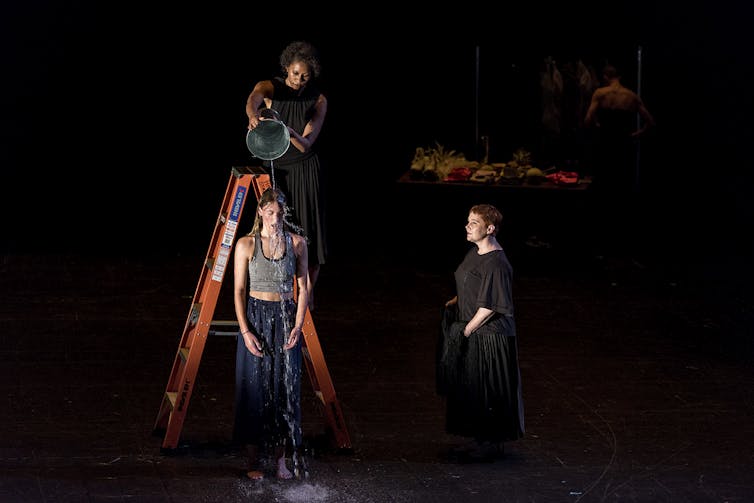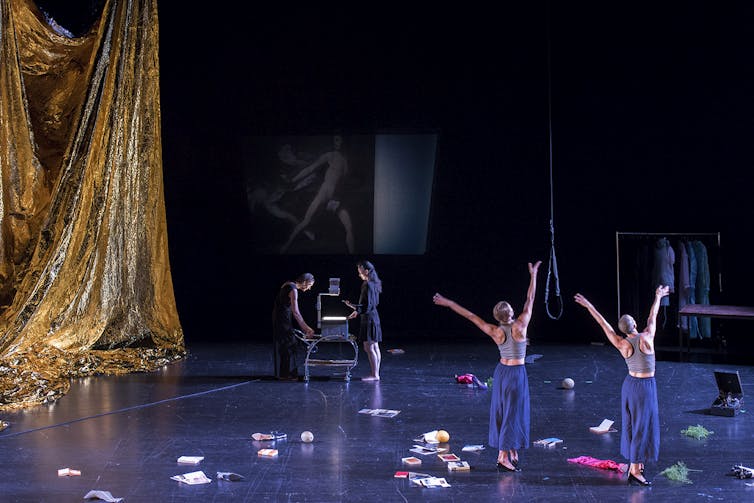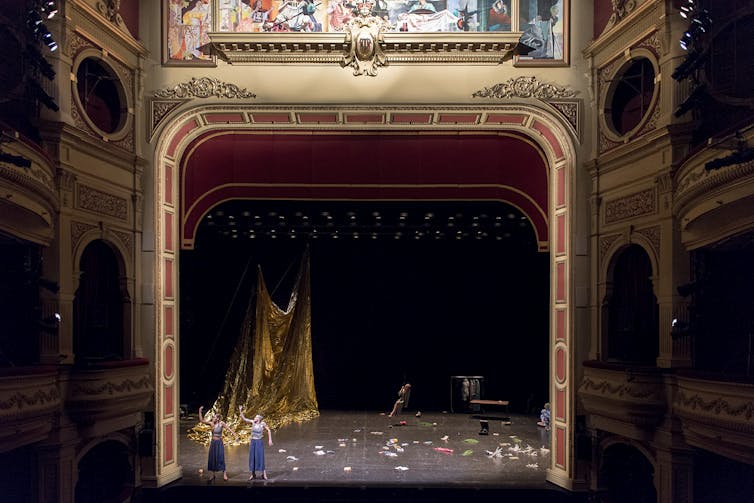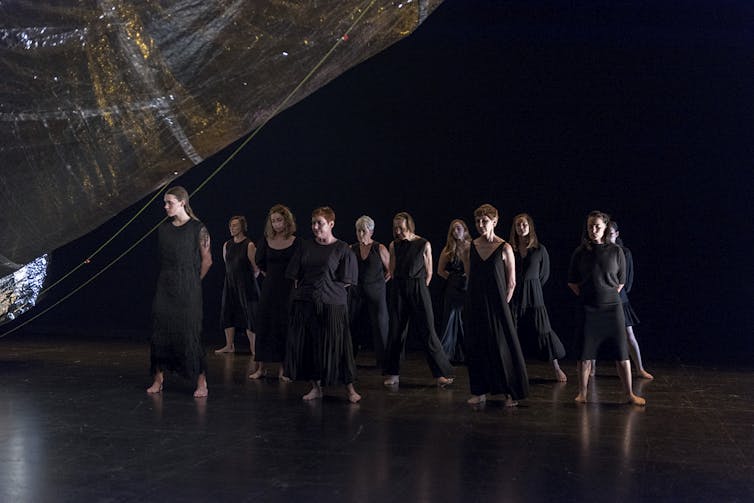Source: The Conversation (Au and NZ) – By Leah Mercer, Associate Professor of Theatre Arts, Curtin University
Review: Slow Burn, Together, choreographed by Emma Fishwick. Emma Fishwick and Performing Lines for Perth Festival.
It goes against the very core of Slow Burn, Together to respond to it so quickly in print. In the program, choreographer Emma Fishwick quotes art historian Ernst Gombrich: “the reading of a picture needs a very long time.”
Slow Burn, Together encourages a dream-like reflection on our relationship with time, especially history and progress, how it shapes us, how we work with it and against it.
Moving through the cavernous stage of Perth’s Her Majesty’s Theatre — on foot, on wheels, on their knees, on a swing — an ensemble of 15 women create an ever-changing series of pictures. Evoking pathways to the past or into an unknown future, the dancers shift between movement and stillness, horizontal and vertical, witnessing and being witnessed.
Against the backdrop of a giant golden sail, with the bare bones of the theatre on display, everything is exposed.An amorphous sense of time
Slow Burn, Together performs a delicate magic act that manipulates time, slowing down the tempo of the audience.
I am reminded of the words of American theatre director Anne Bogart, who describes this sensation as those moments in the theatre when “the laws of space and time” alter radically and the audience enter “the poetic realm”.
In this realm, time seems “to stop and expand at the same time”.
This sense occurs here in the meditative quality of performers and audience breathing together.

The all-female cast is made up of many different types of women: senior dancers, some of whom have taught, mentored and worked with Fishwick; younger dancers who are new to her practice. Seeing these bodies — old, young, different shapes, sizes and ethnicities — take up space with an aura of persistent stillness, the female gaze replaces the usual male one.
Gradually, an array of objects are introduced into the picture: high heel shoes, random books, coconuts. A gramophone, in conjunction with Tristen Parr’s sound design, draws attention to the ways music cuts across time to meet us in this moment.
Balanced with extended moments of silence, the performers also work in glorious tandem with Chris Donnelly’s evocative lighting design, through which we alternatively glimpse and gape at the kaleidoscopic images.
Women through women’s eyes
The representation of women through art’s male gaze is directly referenced in projected paintings from Baroque and pre-Raphaelite masters.
These images are reconstructed in a number of artfully-composed tableaus where the dancers’ bodies seem to transform from flesh to form before our eyes. Exposing the effort and construct behind these seemingly perfect images, they also deconstruct these paintings in moments of gentle, wry humour.

There are two central duets by Ella-Rose Trew and Francesca Fenton. The second is an exercise in endurance, a sort of aerobics-class-meets-contemporary-dance that moves them from an exquisite, unified precision to an exhausted, deliberately looser partnership.
This gradual loss of finesse exposes us to the effort it takes to appear effortless.
The duration of these duets creates time and space for us to reflect upon our act of witnessing. There is rarely just one focal point; our eyes gaze at the different moments occurring simultaneously around the stage.

Coming back to the duets in our own time, at our own pace, we bring our dreamy associations with us. These multiple worlds evoke a stream of consciousness response: beauty and aging; past and present; our familial and creative ancestors and descendants. Images of the French stage actress Sarah Bernhardt (1844-1923), who once graced this same stage, and Maggi Phillips (1944-2015), the doyen of Australian dance and scholarship, especially in Western Australia, fluttered before my eyes.
Strength in unity
In this week of International Women’s Day, this year where the Australian of the Year is speaking out about sexual assault, this month when we have highly-publicised utterings of what happens to women’s bodies and minds as a result of sexual assault, I was also reminded of the increasing profile and articulation of women’s rage.
These silent women of Slow Burn, Together — across generations, watching each other, watching out for one another — seemed to speak to this moment in Australian history.

The piece culminates in a gorgeous coming together of the ensemble. There is something very satisfying about watching a group of people move in unison after so much asynchronicity.
What’s the collective noun for an ensemble of women dressed in black, performing a delicate choreography with their feet, while their hands remain hooked behind their backs? I suggest a haunting.
There’s an eerie strength in this vignette of unity. Then, just as quickly Bogart’s poetic realm disassembles and we are returned to her “bricks and mortar” of the theatre.
Slow Burn, Together is at His Majesty’s Theatre, Perth, until Sunday March 14.
– ref. ‘Articulation of women’s rage’: Slow Burn, Together and its haunting of women dancers – https://theconversation.com/articulation-of-womens-rage-slow-burn-together-and-its-haunting-of-women-dancers-154270







